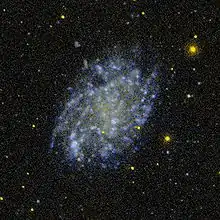NGC 45
NGC 45 is a low surface brightness spiral galaxy[3] in the constellation of Cetus. It was discovered on 11 November 1835 by the English astronomer John Herschel.
| NGC 45 | |
|---|---|
 NGC 45 by GALEX (ultraviolet) | |
| Observation data (2000.0 epoch) | |
| Constellation | Cetus |
| Right ascension | 00h 14m 3.99s |
| Declination | −23° 10′ 55.5″ |
| Redshift | 0.001558[1] |
| Helio radial velocity | 467 km/s[1] |
| Distance | 32.6 ± 10 Mly (10 ± 3.1 Mpc)[2] |
| Apparent magnitude (V) | 10.4 |
| Characteristics | |
| Type | SA(s)dm[1] |
| Apparent size (V) | 7.41′ × 5.13' |
| Other designations | |
| UGCA 4, MCG 04-01-21, PGC 930, LEDA 930 | |
Unlike the Milky Way, NGC 45 has no clear defined spiral arms, and its center bar nucleus is also very small and distorted. NGC 45 thus does not have a galactic habitable zone.[4][5][6] For the Milky Way, the galactic habitable zone is commonly believed to be an annulus with an outer radius of about 10 kiloparsecs and an inner radius close to the Galactic Center, both of which lack hard boundaries.[5]
References
- NASA NED, "NGC 0045" (accessed 20 April 2010)
- "Distance Results for NGC 0045". NASA/IPAC Extragalactic Database. Retrieved 4 May 2010.
- "NGC 45". SIMBAD. Centre de données astronomiques de Strasbourg.
- Caltech, II. MORPHOLOGY, #34
- Gowanlock, M. G.; Patton, D. R.; McConnell, S. M. (2011). "A Model of Habitability Within the Milky Way Galaxy". Astrobiology. 11 (9): 855–873. arXiv:1107.1286. Bibcode:2011AsBio..11..855G. doi:10.1089/ast.2010.0555. PMID 22059554. S2CID 851972.
- Choi, Charles Q. (21 August 2015). "Giant Galaxies May Be Better Cradles for Habitable Planets". Space.com. Retrieved 24 August 2015.
External links
 Media related to NGC 45 at Wikimedia Commons
Media related to NGC 45 at Wikimedia Commons- NGC 45 on WikiSky: DSS2, SDSS, GALEX, IRAS, Hydrogen α, X-Ray, Astrophoto, Sky Map, Articles and images
This article is issued from Wikipedia. The text is licensed under Creative Commons - Attribution - Sharealike. Additional terms may apply for the media files.